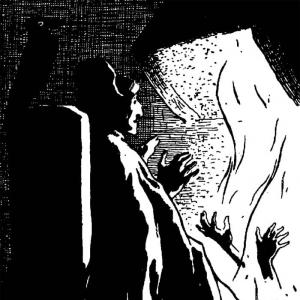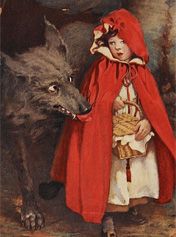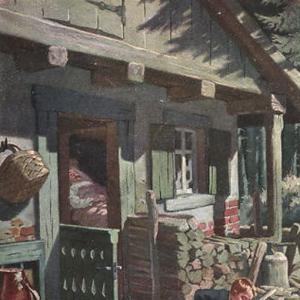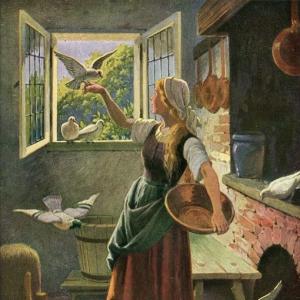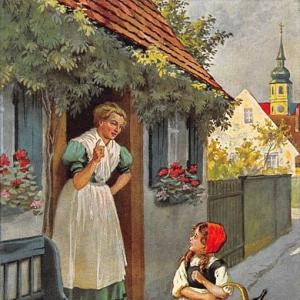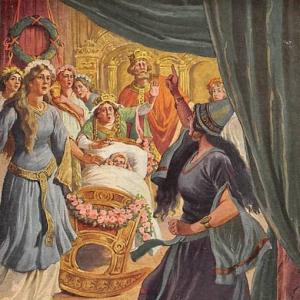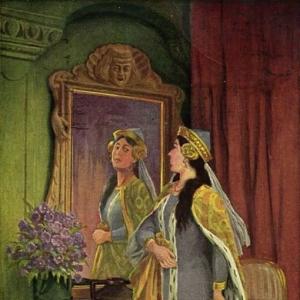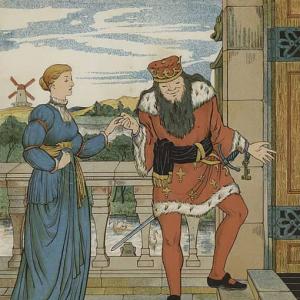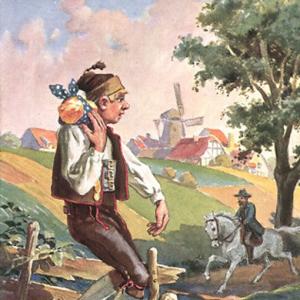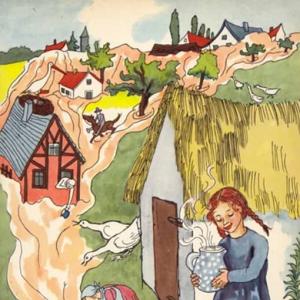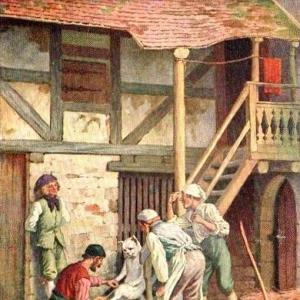Reading time: 4 min
There was once a tailor, who was a quarrelsome fellow, and his wife, who was good, industrious, and pious, never could please him. Whatever she did, he was not satisfied, but grumbled and scolded, and knocked her about and beat her. As the authorities at last heard of it, they had him summoned, and put in prison in order to make him better. He was kept for a while on bread and water, and then set free again. He was forced, however, to promise not to beat his wife any more, but to live with her in peace, and share joy and sorrow with her, as married people ought to do. All went on well for a time, but then he fell into his old ways, and was surly and quarrelsome. And because he dared not beat her, he would seize her by the hair and tear it out. The woman escaped from him, and sprang out into the yard, but he ran after her with his yard-measure and scissors, and chased her about, and threw the yard-measure and scissors at her, and whatever else came his way. When he hit her he laughed, and when he missed her, he stormed and swore. This went on so long that the neighbors came to the wife’s assistance. The tailor was again summoned before the magistrates, and reminded of his promise. „Dear gentlemen,“ said he, „I have kept my word, I have not beaten her, but have shared joy and sorrow with her.“ – „How can that be,“ said the judge, „when she continually brings such heavy complaints against you?“ – „I have not beaten her, but just because she looked so strange I wanted to comb her hair with my hand; she, however, got away from me, and left me quite spitefully. Then I hurried after her, and in order to bring her back to her duty, I threw at her as a well-meant admonition whatever came readily to hand. I have shared joy and sorrow with her also, for whenever I hit her I was full of joy, and she of sorrow, and if I missed her, then she was joyful, and I sorry.“ The judges were not satisfied with this answer, but gave him the reward he deserved.
 Learn languages. Double-tap on a word.Learn languages in context with Childstories.org and Deepl.com.
Learn languages. Double-tap on a word.Learn languages in context with Childstories.org and Deepl.com.Backgrounds
Interpretations
Adaptions
Summary
Linguistics
„Sharing Joy and Sorrow“ is a lesser-known fairy tale collected by the Brothers Grimm, Jacob and Wilhelm, in their famous compilation „Grimm’s Fairy Tales.“ The Brothers Grimm were German linguists, cultural researchers, and authors who lived in the late 18th and early 19th centuries. They are best known for their collection of fairy tales, which they compiled as part of their work on German folklore and culture.
The Brothers Grimm initially published their collection of fairy tales, known as „Kinder- und Hausmärchen“ (Children’s and Household Tales), in 1812. The collection contains stories passed down through generations, and the brothers gathered these tales from various sources, including oral retellings, written documents, and other storytellers. The collection went through several editions during their lifetimes, with each edition featuring more stories and revisions.
„Sharing Joy and Sorrow“ is one of the many fairy tales included in this collection. Although it is not as famous as other Grimm fairy tales like „Cinderella,“ „Snow White,“ or „Hansel and Gretel,“ it still carries important messages and themes, such as the consequences of abuse, the importance of empathy and compassion, and the role of society in protecting vulnerable individuals.
The Grimm Brothers‘ fairy tales have had a lasting impact on literature, art, and popular culture, influencing generations of authors, filmmakers, and artists. Their stories have been translated into numerous languages, adapted into various formats, and continue to be cherished by readers of all ages worldwide.
„Sharing Joy and Sorrow“ can be interpreted in various ways, with the following interpretations being some of the most notable:
Abuse and manipulation: The story highlights the issue of abuse within relationships and the manipulative tactics employed by abusers. The tailor finds ways to justify his actions and tries to convince the authorities that he is not breaking his promise. This reflects the manipulative behavior often displayed by abusers in real-life situations.
The role of society and justice: The tale demonstrates the importance of societal intervention and the role of justice in protecting vulnerable individuals. The neighbors and the magistrates play crucial roles in holding the tailor accountable for his actions and ensuring that he faces the consequences.
Persistence of unhealthy patterns: The story also sheds light on the persistence of unhealthy patterns in relationships. The tailor is initially able to change his ways after facing punishment, but eventually, he reverts to his old behaviors. This highlights the difficulty of breaking free from negative patterns and the need for continuous efforts to maintain healthy relationships.
The importance of empathy and compassion: The tailor’s inability to empathize with his wife’s pain and suffering is a central theme in the story. His twisted interpretation of „sharing joy and sorrow“ is a reminder that true empathy and compassion are essential elements of a healthy and loving relationship.
The power of language and wordplay: The tale showcases the power of language and the use of wordplay as the tailor tries to justify his actions by twisting the meaning of „sharing joy and sorrow.“ This emphasizes the importance of clear communication and mutual understanding in relationships.
The fairy tale „Sharing Joy and Sorrow“ (also known as „The Two Kings“) from the Brothers Grimm has inspired various adaptations in literature, film, and other media. Some notable adaptations include.
„The Two Brothers,“ a play by Friedrich Hebbel (1844): This play is based on „Sharing Joy and Sorrow“ but adds some additional characters and subplots.
„The Sleeping Beauty“ by Charles Perrault (1697): This fairy tale has some similarities to „Sharing Joy and Sorrow,“ including the exchange of gifts (in this case, fairies bestowing gifts on the newborn princess) and a promise made to share joy and sorrow.
„The Two Princesses of Bamarre“ by Gail Carson Levine (2001): This young adult novel is loosely based on „Sharing Joy and Sorrow“ and features two sisters who must embark on a dangerous quest to save their kingdom.
„The Tale of Despereaux“ by Kate DiCamillo (2003): This children’s book features a mouse named Despereaux who falls in love with a princess and must go on a quest to save her from a dungeon, similar to the plot of „Sharing Joy and Sorrow.“
„Frozen“ (2013): This Disney film is loosely based on „Sharing Joy and Sorrow“ and features two sisters who are separated by a curse but eventually reunite and restore their bond.
„Ever After High“ (2013-2016): This animated series features a character named Briar Beauty, who is the daughter of Sleeping Beauty and shares some similarities with the princess in „Sharing Joy and Sorrow.“
Overall, „Sharing Joy and Sorrow“ has inspired various adaptations that have explored its themes of friendship, loyalty, and the power of promises.
„Sharing Joy and Sorrow“ is a fairy tale by Brothers Grimm about a tailor who is a quarrelsome and abusive man, and his wife, who is a good, industrious, and pious woman. The wife can never please her husband, and he constantly grumbles, scolds, and beats her. When the authorities learn of his behavior, they imprison him, forcing him to promise that he will not beat his wife again and will share joy and sorrow with her, as married couples should.
For a while, the tailor behaves well, but eventually, he reverts to his old ways and becomes surly and quarrelsome. Instead of physically beating his wife, he pulls her hair, and when she tries to escape, he chases her with a yard-measure and scissors, throwing them and other objects at her. The tailor laughs when he hits her and becomes enraged when he misses. The neighbors intervene and help the wife, leading to the tailor being summoned before the magistrates again.
The tailor claims he has not broken his promise, stating that he has not beaten his wife and has shared joy and sorrow with her. He explains that he tried to „comb“ her hair with his hand, but she ran away, so he threw objects at her as a „well-meant admonition.“ He claims that he was joyful when he hit her, causing her sorrow, and that she was joyful and he was sorrowful when he missed her. The judges, however, do not accept this explanation and give the tailor the punishment he deserves.
The fairy tale „Sharing Joy and Sorrow“ by the Brothers Grimm presents a narrative that is rich in linguistic and thematic elements typical of traditional folklore.
Below is a linguistic analysis of the tale:
Characters and Characterization
The Tailor:
Description: The tailor is depicted as a „quarrelsome fellow,“ highlighting his negative traits from the outset.
Actions: His behavior includes grumbling, scolding, and physically abusing his wife, indicating a character who is both verbally and physically abusive.
Speech: His dialogue with the authorities is manipulative. By stating that he „shared joy and sorrow,“ he uses language to twist the meaning of social conventions to justify his actions.
The Wife
Description: Described as „good, industrious, and pious,“ which contrasts sharply with her husband’s portrayal. This creates a moral dichotomy typical of fairy tales.
Actions: Her responses are largely passive, reflecting a traditional, subservient role expected of women in historical narratives.
Silence/Presence: Her lack of direct speech highlights her disempowerment and victimhood.
Themes
Domestic Abuse: The tale portrays domestic violence vividly, with the tailor’s abuse initially unchecked by social or legal consequences, reflecting societal norms where such behavior might have been overlooked or inadequately addressed.
Manipulation of Language and Promises: The tailor manipulates language to excuse his behavior, claiming adherence to societal and marital norms of „sharing joy and sorrow“ while redefining ‚joy‘ and ’sorrow‘ to suit his narrative. This reflects themes of deception and the inadequacy of societal measures in protecting the victimized.
Justice and Social Order: The intervention by authorities highlights the social mechanisms in place for justice, although initially ineffective. The ultimate punishment of the tailor suggests a moral lesson prevalent in fairy tales: wrongdoing will eventually be met with justice.
Descriptive Language: The use of adjectives like „quarrelsome,“ „good,“ „industrious,“ etc. , contributes to the characterization and moral judgments of the characters.
Dialogue: The direct speech of the tailor contains irony and manipulation, serving to illustrate his deceit and the theme of misunderstood justice.
Repetition: The cycle of the tailor’s behavior (promising to change, then reverting to abuse) is an example of repetition within the narrative structure, underscoring the futility of superficial promises.
Symbolism: The yard-measure and scissors are tools of the tailor’s trade, transforming into implements of abuse, symbolizing the perversion of his role and duties.
Conclusion
The tale utilizes typical Grimm motifs of character dichotomy, moral lessons, and societal justice, while tackling complex themes like domestic abuse and the manipulation of social norms. Linguistically, it employs descriptive language and dialogue to convey character traits and thematic elements, resulting in a narrative that reflects both the societal values and the moral warnings of its time.
Information for scientific analysis
Fairy tale statistics | Value |
|---|---|
| Number | KHM 170 |
| Aarne-Thompson-Uther-Index | ATU Typ 921D |
| Translations | DE, EN, DA, ES, PT, IT, JA, NL, PL, RU, TR, VI, ZH |
| Readability Index by Björnsson | 33.7 |
| Flesch-Reading-Ease Index | 76.2 |
| Flesch–Kincaid Grade-Level | 8.2 |
| Gunning Fog Index | 11 |
| Coleman–Liau Index | 7.6 |
| SMOG Index | 9.5 |
| Automated Readability Index | 8.5 |
| Character Count | 1.976 |
| Letter Count | 1.512 |
| Sentence Count | 17 |
| Word Count | 380 |
| Average Words per Sentence | 22,35 |
| Words with more than 6 letters | 43 |
| Percentage of long words | 11.3% |
| Number of Syllables | 485 |
| Average Syllables per Word | 1,28 |
| Words with three Syllables | 20 |
| Percentage Words with three Syllables | 5.3% |

 Facebook
Facebook  Whatsapp
Whatsapp  Messenger
Messenger  Telegram
Telegram Reddit
Reddit

